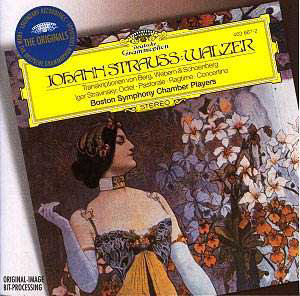What a bizarre record – Vienna’s favourite composer given the
treatment by Vienna’s least favourite ones. Four waltzes from the Vienna
Philharmonic tradition were cunningly stolen by the Second Viennese School
to illustrate their ideas. Gone is the sheen, and in its place the harmony
alone.
Truth be told, it is hard to see the hands of Schoenberg
and his pupils in these beautifully mellifluous transcriptions of favourite
waltzes at first hearing, but the effort to reduce the instrumentation
without subtracting from Strauss’s musical personality must have been
considerable. It is extraordinary that they should have lavished such
care and attention on such crowd pleasers for their Society for Private
Performances, which is now legendary for its advocacy of such spectacularly
controversial works as the First Chamber Symphony and Pierrot Lunnaire.
They can be seen, however, as a part of Schoenberg’s
radical ideas about texture, and its subservient relationship to harmony.
Schoenberg famously favoured harmony over texture – he transcribed Das
Lied Von Der Erde for 13 instruments to prove it – and what is especially
pleasing about these waltzes is that, not only do they survive the reduction
in forces, but they gain an extra dimension from the different palette.
The reduction to piano, string quartet and a couple of winds gives them
a beautiful transparency that gives them an increased charm. They still
have the marvellous poise and elegance that Strauss imbued his music,
but the gloss has been taken off, and Schoenberg shows us that the structure
is as beautiful as the façade. Any more than four and I would
have turned into a strawberry bon-bon, but as they are they are exquisite.
The performances are delightful – the Boston players were a very fine
collection. Their sound is divine, and they oom-pah-pah with the utmost
refinement.
Composers as diverse as Tchaikovsky and Pergolesi may
have all been fuel for Stravinsky’s neo-classical engine, but there
isn’t much synergy between Strauss and the Stravinsky chamber music
that fills up the rest of the disc. No matter: it's very fine Stravinsky
in very fine performances. Ragtime is an excellent performance – the
players really get under the skin of this pungent little miniature,
as they do with the Concertino. The Octet, while sensitively played,
feels a little underpowered, and meanders a little in the quieter sections.
I would not recommend this disc on the strength of the Stravinsky alone
- those looking for these works will find them all with the Septet in
an even finer recording by Vladimir Ashkenazy and the European Soloists
on Decca – but they do make interesting listening as a bonus to the
Strauss waltzes.
Aidan Twomey


